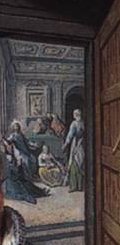
My Daily Art Display offering for today is the fourth and final painting in Joachim Beuckelaer’s set of pictures, which he painted in 1569-1570 entitled The Four Elements. Today’s painting is entitled The Four Elements: Fire. The Ancient Greeks believed that the cosmos was made up of four elements, namely, Earth, Air, Fire and Water and thus the reasoning behind the artist’s four-picture set. The painting today moves away from the market stalls where we saw women buying vegetables, poultry and fish and that were featured in the previous three works of art. Instead, today we move to a kitchen scene in which the produce that has been bought at the various market stalls will be cooked. To do the cooking one needs fire, hence the subtitle to this painting.
This painting, like the other three was completed in Beuckelaer’s studio for an Italian patron. This genre of painting was very popular with the local populace. The abundance of food in the paintings did not mirror life in the Netherlands at the time as the locals lived under the oppressive regime of the Duke of Alba, a Spanish general who was the governor of the Spanish Netherlands and who was renowned for his cruelty and atrocities against the Flemish and Dutch people.
We look at the kitchen scene from a slightly elevated position. This is a busy kitchen. Probably more than just busy, I think it borders on disarray, almost chaos by the look at the tumbling kitchen bowls in the centre of the composition. Whilst the women are hard at work, the only male in the picture, who is probably a servant or steward drinks to excess and if not careful will end up in the fire! The two women with him seem less than amused at his antics. Beuckelaer’s forte is his still life paintings. Look carefully at the produce. See how he has exquisitely painted the various dead poultry and the sides of ham. No detail has been spared. Look at the way he has painted the earthenware kitchen utensils, some glistening in the sunlight which streams through the kitchen window.
On the floor we can see mussel shells. These sometimes have erotic connotations when seen in paintings. However there may be another meaning to the scattering of these shells in the kitchen scene. The Dutch Golden Age painter of allegories, Adriaen van de Venne said that because mussels stay in their shells they “can be compared to the blessed women-folk who speak modestly and virtuously and always look after their household. So maybe Beuckelaer’s inclusion of the shells on the floor was a tribute to the hard working women in his kitchen scene.

Finally if you look through the door on the left-hand side, you can see another kitchen scene. This is the Biblical story which Beuckelaer has introduced into each of his four paintings. This scene is set in the kitchen of the house of Mary and her sister Martha in which we see Jesus who has come to visit them. The story according to the Bible is that Martha complains to Jesus that although she is working hard in the kitchen, all Mary does is stand around listening to his words. Jesus reproached her saying that Mary’s contemplation was in fact a more important form of her work.
This biblical story was often told to servants in the sixteenth century with sole purpose of stopping them complaining about the amount of servile work they had to carry out. I am not sure that this “parable” would find much favour in present day workers!
So now you have seen all four paintings in The Four Elements set. Some may think the colours rather garish and the scenes at the produce stalls and in the kitchen somewhat chaotic but this painting genre was very popular at the time of Beuckelaer and to be honest I find them both fascinating and of great quality.
